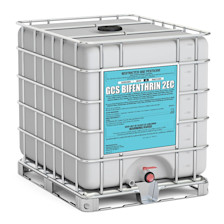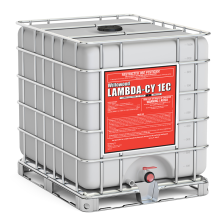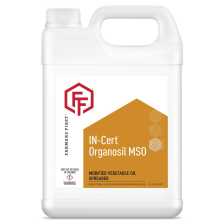Insecticides 101: Everything Farmers Need to Know About Insecticides
This guide includes the following sections:
What Are Insecticides?
Insecticides are toxic substances that kill, deter, repel or mitigate unwanted insects. They are commonly used in agricultural operations to protect animal and crop health and keep grain storage areas pest-free.
Outside of agriculture, insecticides protect building structures, maintain lawns and turf, and minimize disease spread to support public health initiatives.
Insecticides can be applied to nearly every agricultural crop and are used in organic and conventional production systems to protect crop yield and quality. Generally, insecticides reduce pest populations by interfering with a physiological process critical to growth and development.
Many insecticides target an insect’s nervous system to inhibit neuron transmission and kill insects on contact. Other insecticides may interfere with mitochondrial respiration, growth hormone regulation or midgut functioning and may be slower-acting.
Why Do Farmers Use Insecticides?
Farmers use insecticides to reduce insect populations that may be detrimental to crop and animal health. Insects can reduce crop quality and yield by physically damaging plant roots, stems and leaves, thus limiting water and nutrient transport, photosynthetic efficiency and crop stability. Insects also serve as vectors for plant and animal diseases.
Using an effective insecticide for targeted pests provides a range of benefits, including:
Increased farm profitability
Fewer insect vectors (reduction in plant and animal disease risks)
Higher crop yield
Better crop quality
Lower risk of crop losses due to stalk and root quality issues
More efficient harvest with less crop lodging
Insecticide Groups and Mode of Action Classifications
Insecticides are categorized into specific groups based on their mode of action in mitigating pests. Mode of action groups for insecticides include nerve and muscle action, growth regulation, insect midgut and energy metabolism. It’s important to consider insecticide modes of action when developing an integrated pest management strategy to reduce the risk of insecticide resistance.
Nerve and Muscle Action Insecticides
The nerve and muscle mode of action group includes nine insecticide classes that work quickly to control insects by disrupting nerve impulses and muscle control.
Group Number | Mode of Action | Chemical Family | Common Active Ingredients |
1 | Acetylcholinesterase inhibitors | carbamates | methomyl, carbaryl, aldicarb |
organophosphates | acephate, chlorpyrifos, malathion, tebupirimphos | ||
2 | GABA-gated chloride channel blockers | phenylpyrazoles (fiproles) | fipronil |
3 | Sodium channel modulators | pyrethroids, pyrethrins | bifenthrin, lambda-cyhalothrin, cyfluthrin, tefluthrin |
4 | Nicotinic acetylcholine receptor agonists | neonicotinoids | imidacloprid, acetamiprid, clothianidin, thiamethoxam |
sulfoxamines | sufloxaflor | ||
butenolides | flupyradifurone | ||
5 | Nicotinic acetylcholine receptor allosteric activators | spinosyns | spinetoram, spinosad |
6 | Glutamate-gated chloride channel (GluCl) allosteric modulators | avermectins, milbemycins | abamectin |
9 | Chordotonal organ TRPV channel modulators | pyropenes | afidopyropen |
22 | Voltage-dependent sodium channel blockers | indoxacarb | indoxacarb |
28 | Ryanodine receptor modulators | diamides | chlorantraniliprole, cyantraniliprole |
Growth Regulation Insecticides
The growth regulation mode of action group includes four insecticide classes that control insect development by disrupting cuticle formation/deposition or lipid biosynthesis. Insect growth regulators are generally slow to act compared to nerve and muscle mode-of-action insecticides.
Group Number | Mode of Action | Chemical Family | Common Active Ingredients |
10 | Mite growth inhibitors | clofentezine, hexythiazox | hexythiazox |
etoxazole | etoxazole | ||
15 | Inhibitors of chitin biosynthesis | benzoylureas | diflubenzuron, novaluron |
18 | Inhibitors of acetyl CoA carboxylase | diacylhydrazines | |
23 | Nicotinic acetylcholine receptor agonists | tetronic and tetramic acid derivatives | spiromesifen, spirotetramat |
Insect Midgut Insecticides
The insect midgut mode of action group includes one insecticide class specific to lepidopteran species. It contains microbial toxins sprayed or expressed in transgenic crop varieties to disrupt the membranes of the insect’s midgut.
Group Number | Mode of Action | Chemical Family | Common Active Ingredients |
11 | Microbial disruptors of insect midgut membranes | Bacillus thuringiensis (Bt) | Bacillus thuringiensis (Bt), cry toxin |
Energy Metabolism Insecticides
The energy metabolism mode of action group includes one insecticide class that inhibits electron transport and/or oxidative phosphorylation, interfering with mitochondrial respiration. Energy metabolism insecticides are generally moderately to fast-acting.
Group Number | Mode of Action | Chemical Family | Common Active Ingredients |
12 | Inhibitors of mitochondrial ATP synthase | propargite | propargite |
When to Apply Insecticide
Insect pressure will vary year-to-year based on field and environmental conditions. For example, corn rootworm larvae may be drowned out in wet springs, resulting in lower insect pressure and root damage.
Insect development depends on growing degree days (GDD), a measurement of heat accumulation over time. Generally, warmer conditions result in faster insect development, which could increase crop damage risks. Knowing the typical GDD required for insect development and monitoring GDDs for your fields can help you plan your insect scouting strategy and insecticide applications. Timely insecticide applications are critical for effective and profitable insect control.
It’s also important to define the economic threshold for particular insect pests. In some situations, insect populations may not be significant enough to warrant the expense of an insecticide application, or insects may develop late enough that risks to a crop are minimal. The application threshold will vary depending on the cost to treat a field and the crop’s expected value. Work with your agronomist to define the economic threshold before applying an insecticide.
Insecticides may be applied as:
A seed treatment
In-furrow at planting
A foliar spray, often in conjunction with a fungicide application.
Consult the insecticide label for specific application timing instructions.
How to Apply Insecticide
Every insecticide will include different application instructions, depending on whether the insecticide is applied as a seed treatment, in-furrow or foliar spray. Foliar spray applications require more diligent planning to ensure adequate crop coverage. Watch weather conditions to avoid spraying on windy days.
Insecticides can harm humans, so following strict safety precautions and label instructions is important when applying them. When handling chemicals, most insecticide labels call for appropriate personal protective equipment, including long shirts, pants, close-toed shoes, goggles, and gloves.
In addition, every insecticide label includes a re-entry interval (REI), which indicates how long the treated area must remain restricted for entry following an insecticide application. REIs may be hours or even days, depending on the chemical applied. You should also be aware of the harvest interval, which indicates when it is safe to harvest a crop after an insecticide has been applied.
How to Address Crop Pests Using Insecticides
Using Insecticide to Treat Bean Leaf Beetles
Bean leaf beetles feed on soybean seedlings and are often more prevalent in the first-planted soybean fields. These insects may be difficult to see when scouting as they are often on the underside of leaves. Soybean yield and quality can be compromised by extensive leaf and pod feeding. Bean leaf beetles may also spread bean pod mottle virus or secondary fungal infections to pods during feeding. Iowa State University reports the economic threshold for bean leaf beetle control is between two and eight beetles per plant, depending on the cost of treatment and crop value.
Foliar insecticides, including bifenthrin*, imidacloprid, and lambda-cyhalothrin*, can control bean leaf beetles in soybeans. Treatments may be made before flowering if beetles are present and defoliation reaches 30%. From flowering to pod fill, treat fields if beetles are present and defoliation reaches 20%.
Follow labeled application rates and scout fields after application to ensure there is no re-colonization. Consider using an insecticidal seed treatment if there is a history of early bean leaf beetle pressure in fields.
Using Insecticide to Treat Rootworm Beetles
Western and northern corn rootworm beetles may feed on corn silks, disrupting successful pollination. Corn rootworm beetles lay eggs that overwinter and become corn rootworm larvae that can cause extensive yield threats to a corn crop. Reducing adult beetle populations can reduce the number of corn rootworm larvae hatching the following season.
While there isn’t a well-established economic threshold for treating a crop for silk-feeding, it may be beneficial to consider treatment if adult populations exceed one to five beetles per plant (depending on treatment cost and crop value) to reduce larvae populations.
Multiple insecticide applications may be required as extended egg hatch and beetles migrating from surrounding fields repopulate the field. Because of this, it may not be cost-effective to manage corn rootworm beetles to reduce corn rootworm larvae in the subsequent season. Consult with your agronomist to determine whether a spray application makes economic sense.
If insecticide treatment is warranted, consider applying a foliar spray that uses multiple modes of action to control insecticide-resistant populations. Products containing bifenthrin* or lambda-cyhalothrin* are effective for corn rootworm beetle control.
It is often more cost-effective to control the insect during the larval stage. In that case, using soil-applied insecticides like tefluthrin or chlorpyrifos at planting can reduce larval rootworms and, thus, adult beetles.
Seed treatments and Bt-traited corn hybrids can also offer protection against corn rootworm larvae. All strategies should be considered as part of an integrated pest management plan. Cultural practices, such as crop rotation, are also effective in managing corn rootworm populations.
Using Insecticide to Treat Corn Earworm
Corn earworms feed on corn foliage but prefer the more nutritious ear kernels. Extensive feeding can cause significant losses for sweet and seed corn producers. Corn earworms not only affect crop yield but also quality. The frass they excrete reduces storage life and crop appearance, and corn earworms increase the risk of ear molds.
Corn earworm larvae must be controlled before they enter the corn ear to prevent crop damage. A foliar insecticide spray that includes active ingredients like lambda-cyhalothrin*, gamma-cyhalothrin or alpha-cypermethrin can ensure that young larvae will contact a lethal dose of insecticide before they’re able to bore into the corn ear.
The first insecticide spray should be applied within two days of the beginning of silking. Multiple applications may be required to control newly hatched eggs. If multiple applications are needed, rotate modes of action to reduce the risk of insecticide resistance. Once silks brown, egg-laying should cease.
How to Put Together the Right Mix
Adding an effective adjuvant to the insecticide spray application can help reduce spray drift risks and keep more active ingredients on target. Other adjuvant classes can help penetrate waxy plant cuticles to aid in foliar insecticide leaf absorption.
IN-Cert™ Organosil MSO contains a methylated seed oil (MSO) for improved crop canopy and leaf cuticle penetration. Insecticides may be sensitive to pH, so be aware of the spray solution pH and add appropriate acidifiers or buffers to maintain adequate pH levels in the spray tank. Be sure to review product labels to ensure proper mixing order.
Adding an Insecticide to the Fungicide Pass
Tank mixing an insecticide with a fungicide application is an efficient way to promote plant health while reducing insect populations that have reached the economic threshold for control. For an insecticide/fungicide mix to be effective, the timing has to be optimal for both products. A split application may be a better option to maximize ROI if the optimum timings for both products don’t align.
It’s also important to ensure the products you wish to tank mix are registered for use together. If they’re not, there could be crop or equipment damage. Finally, follow label mixing instructions for the most effective results.
Buy Insecticide from FBN®
FBN has the diverse array of insecticides you need to proactively manage insects and keep your operation running smoothly. With 24/7 digital shopping access, direct-to-farm delivery, transparent pricing and savings opportunities, and detailed label information available for each product, FBN offers the information and products you need to make an effective crop protection strategy this season.
Popular Insecticides Available from FBN:
Related Resources
Acetochlor 101: Everything Farmers Need to Know About Acetochlor
Atrazine 101: Everything Farmers Need to Know About Atrazine
Bifenthrin 101: Everything Farmers Need to Know About Bifenthrin
Biostimulants 101: Everything Growers Need to Know About Biostimulants
Clopyralid 101: Everything Farmers Need to Know About Clopyralid
Clethodim 101: Everything Farmers Need to Know About Clethodim
Crop Nutrition 101: Everything Farmers Need to Know About Crop Nutrition
Fungicides 101: Everything Farmers Need to Know About Fungicides
Glyphosate 101: Everything Farmers Need to Know About Glyphosate
Glufosinate 101: Everything Farmers Need to Know About Glufosinate
Herbicides 101: Everything Growers Need to Know About Herbicides
Inoculants 101: Everything Farmers Need to Know About Inoculants
Insecticides 101: Everything Farmers Need to Know About Insecticides
Lambda-Cyhalothrin 101: Everything Farmers Need to Know About Lambda-Cy
Metolachlor: Everything Farmers Need to Know About Metolachlor
Nitrogen 101: Everything Farmers Need to Know About Nitrogen
Paraquat 101: Everything Farmers Need to Know About Paraquat
© 2014 - 2025 Farmer's Business Network, Inc. All rights Reserved. The sprout logo, “Farmers Business Network”, “FBN”, "Farmers First", “FBN Direct” , "F2F", and "F2F Genetics Network" are trademarks or registered trademarks of Farmer's Business Network, Inc.
Bifenthrin and lambda-cyhalothrin are restricted use pesticides.
FBN Direct products and services and other products distributed by FBN Direct are offered by FBN Inputs, LLC and are available only in states where FBN Inputs, LLC is licensed and where those products are registered for sale or use, if applicable. If applicable, please check with your local extension service to ensure registration status. Nothing contained on this page, including the prices listed should be construed as an offer for sale, or a sale of products. All products and prices are subject to change at any time and without notice and excludes CA mills tax and MN ACRRA fees. Terms and conditions apply.
ALWAYS READ AND FOLLOW LABEL DIRECTIONS. It is a violation of federal and state law to use any pesticide product other than in accordance with its label. The distribution, sale and use of an unregistered pesticide is a violation of federal and/or state law and is strictly prohibited. We do not guarantee the accuracy of any information provided on this page or which is provided by us in any form. It is your responsibility to confirm prior to purchase and use that a product is labeled for your specific purposes, including, but not limited to, your target crop or pest and its compatibility with other products in a tank mix and that the usage of a product is otherwise consistent with federal, state and local laws. We reserve the right to restrict sales on a geographic basis in our sole discretion. You must have a valid applicator license to use restricted use pesticides. Please consult your state department of agriculture for complete rules and regulations on the use of restricted use pesticides, as some products require specific record-keeping requirements.
All product recommendations and other information provided is for informational purposes only. It is not intended to be a substitute for consulting the product label or for specific agronomic, business,or professional advice. Where specific advice is necessary or appropriate, consult with a qualified advisor. Neither Farmer's Business Network Inc. nor any of its affiliates makes any representations or warranties, express or implied, as to the accuracy or completeness of the statements or any information contained in the material and any liability therefore is expressly disclaimed.




